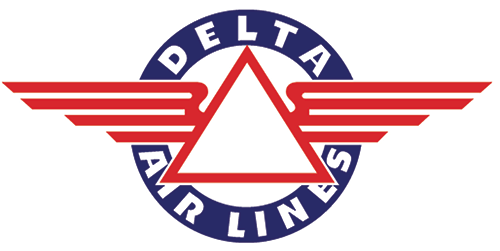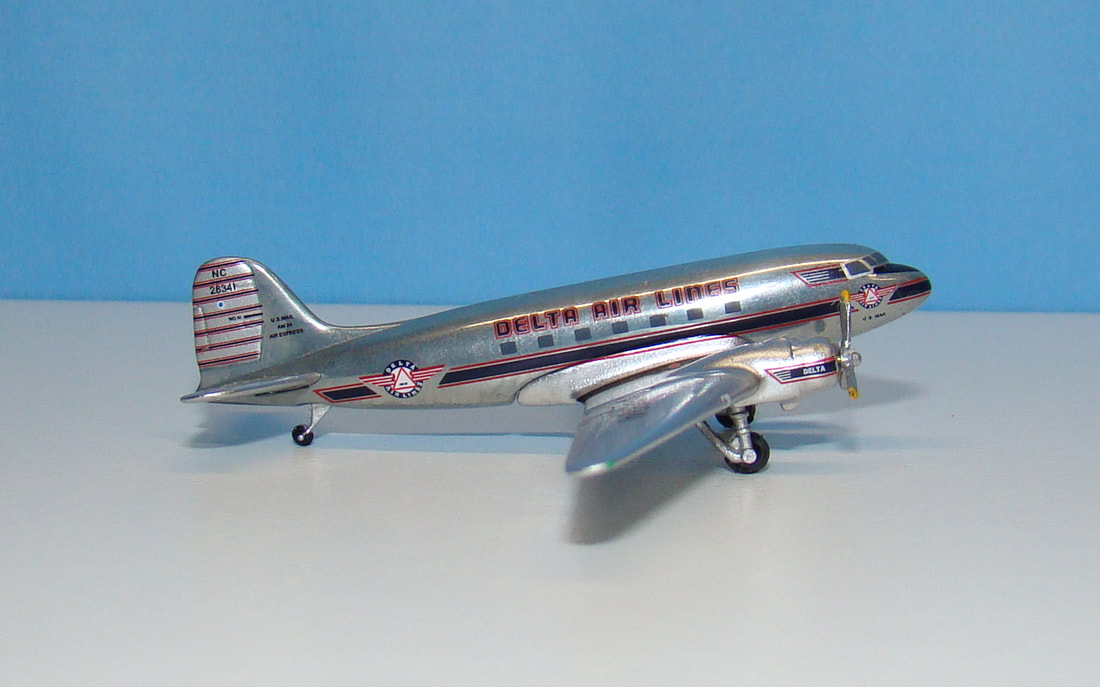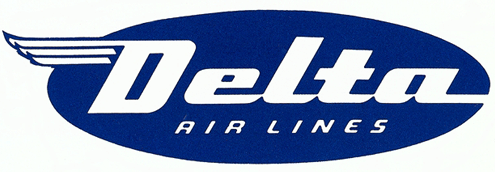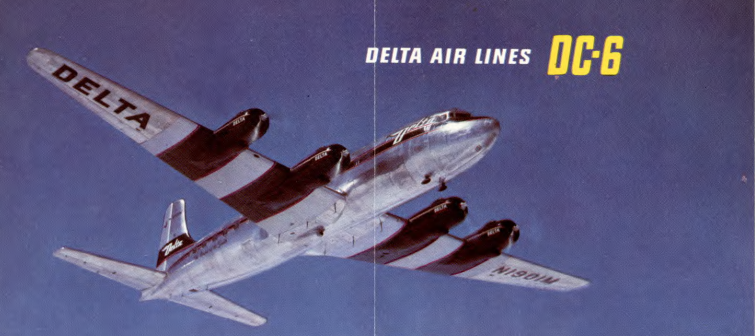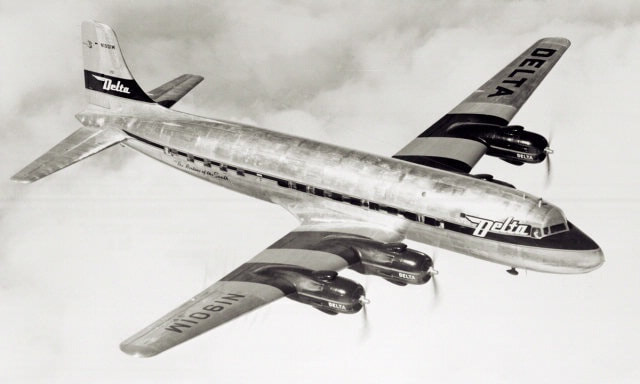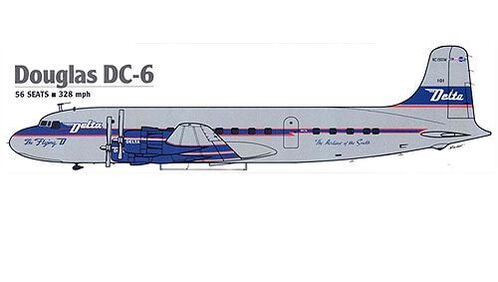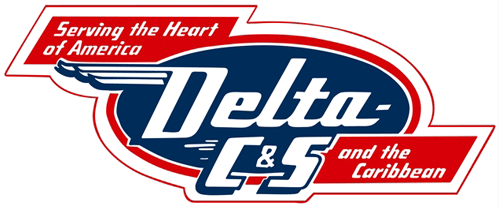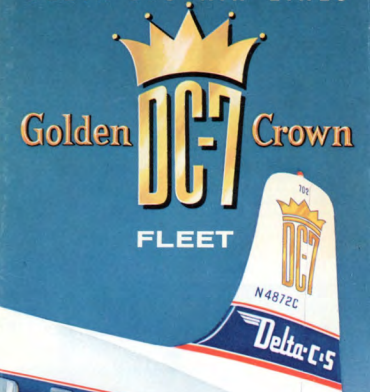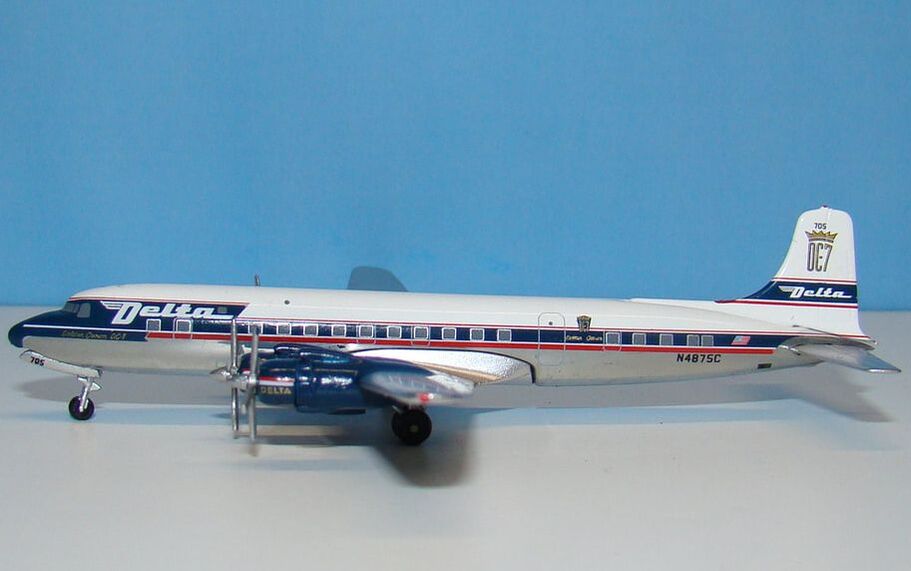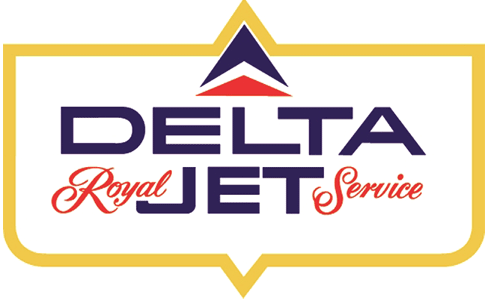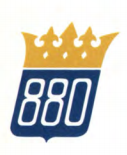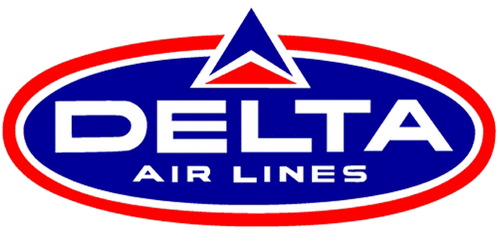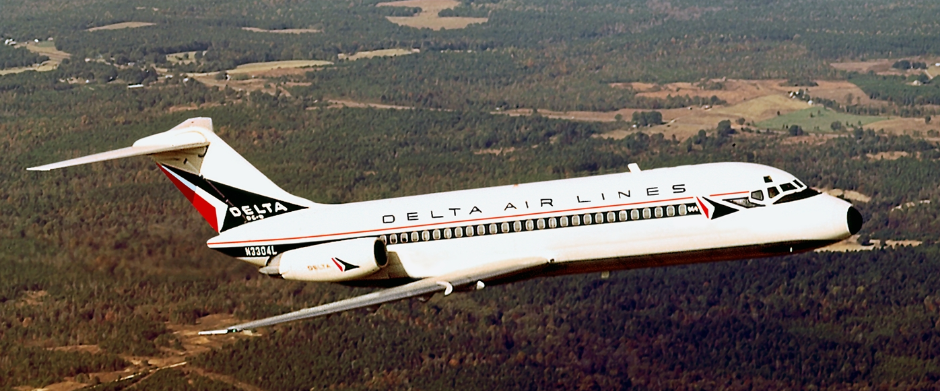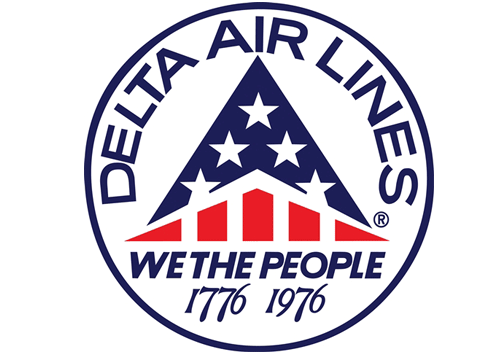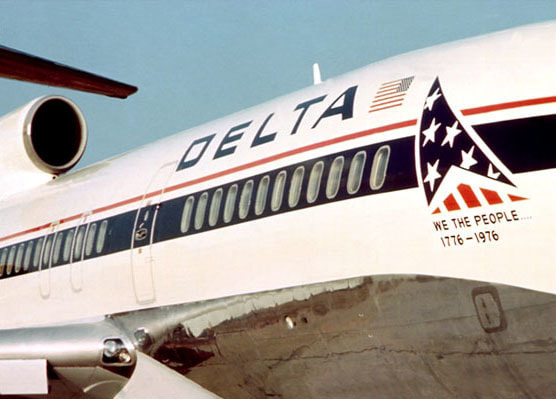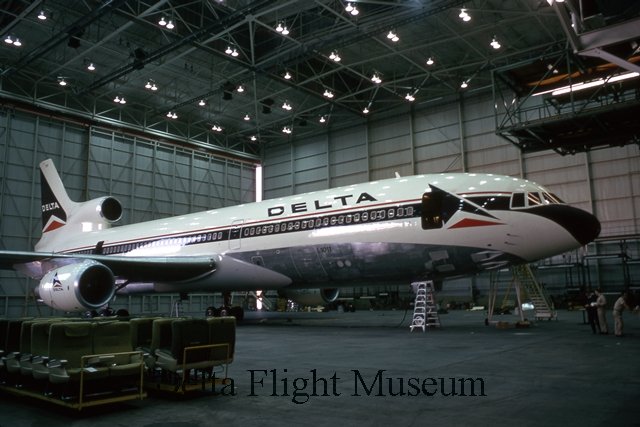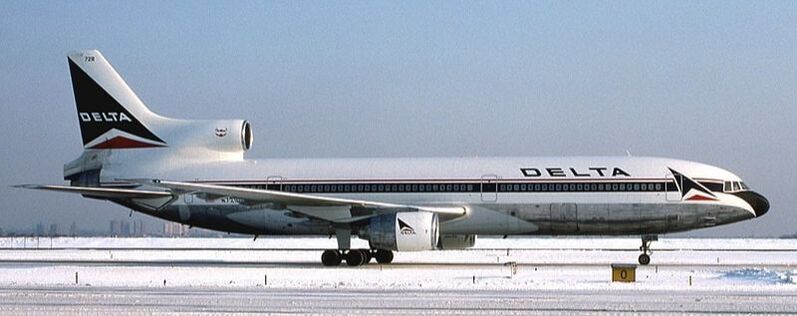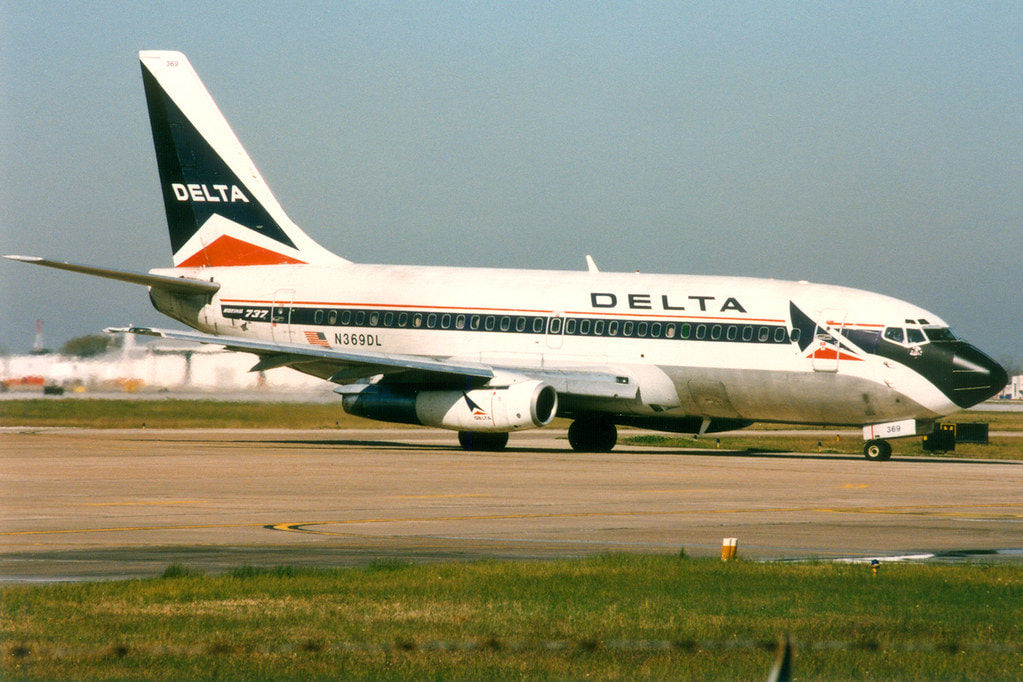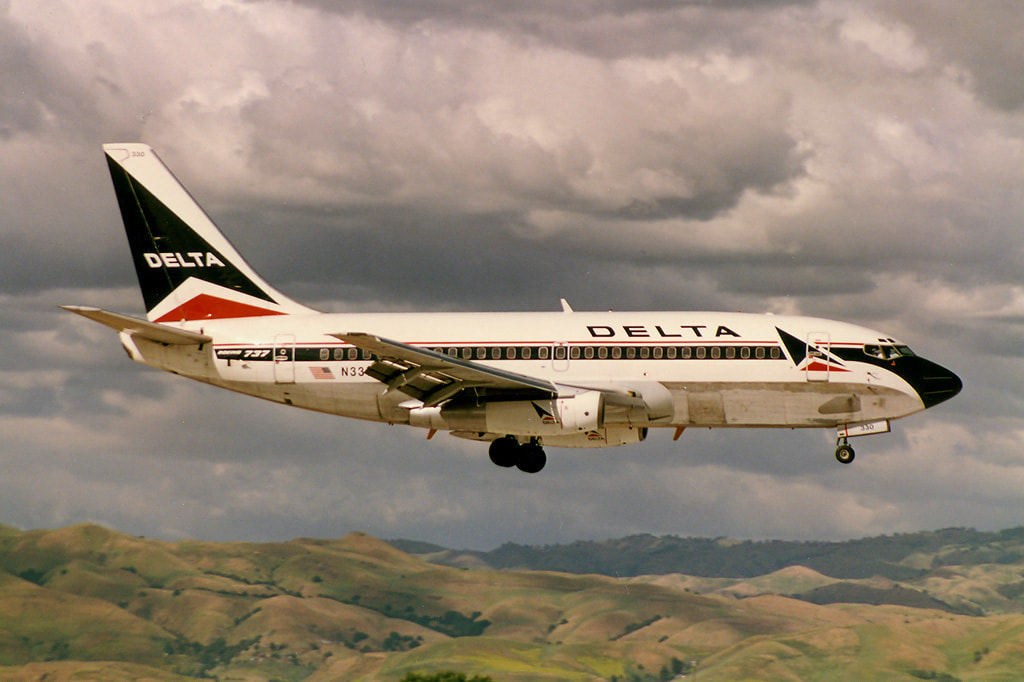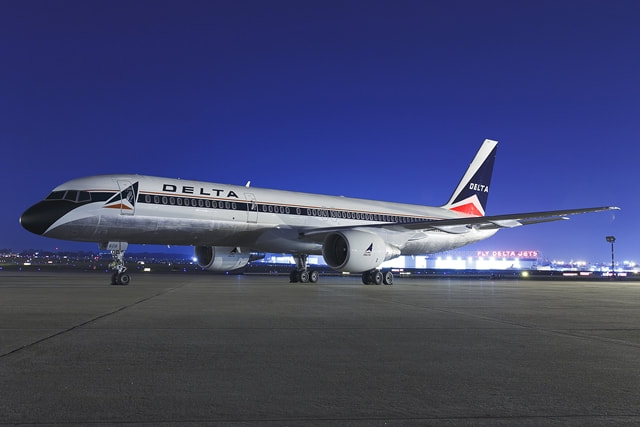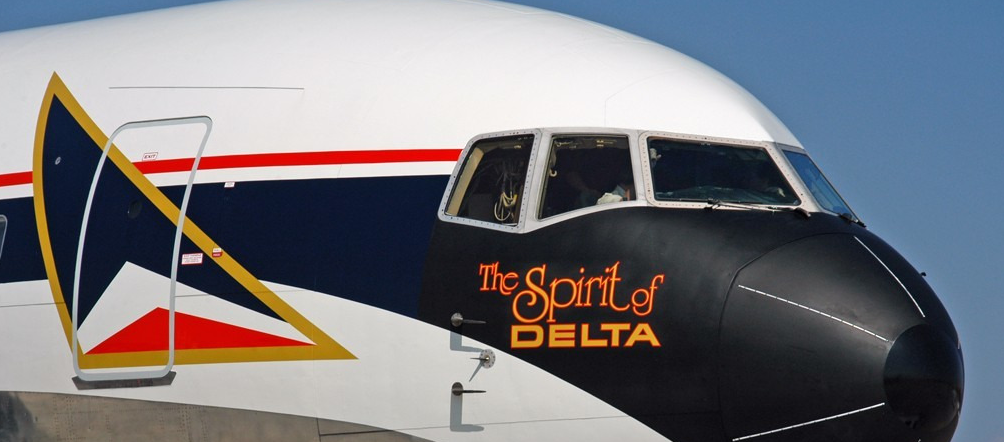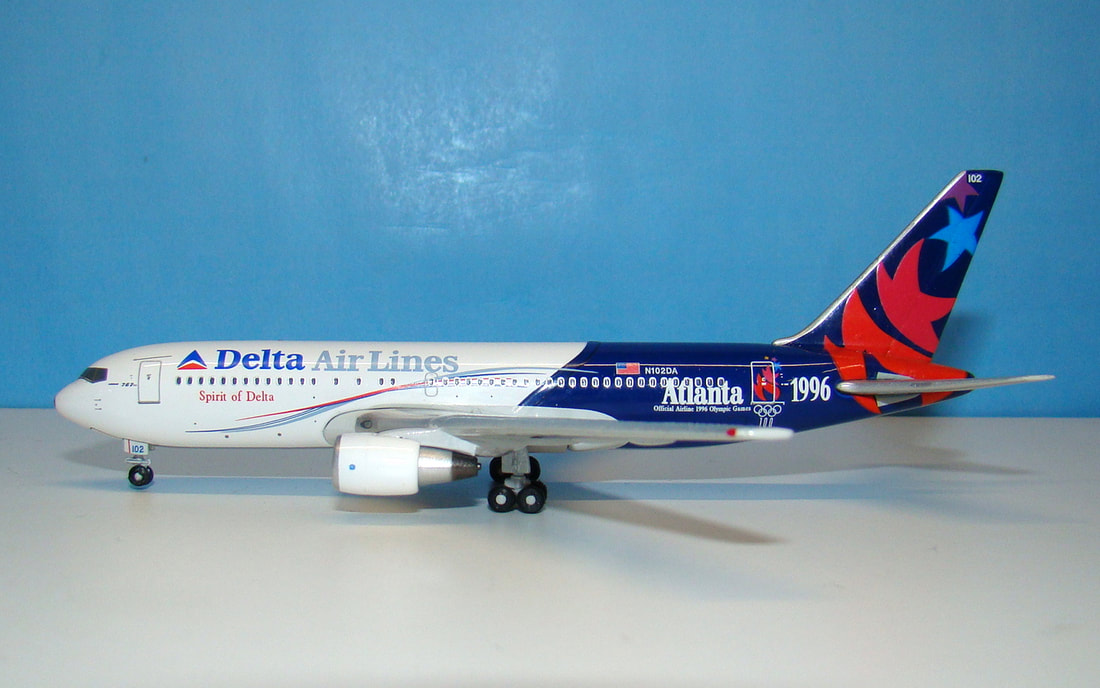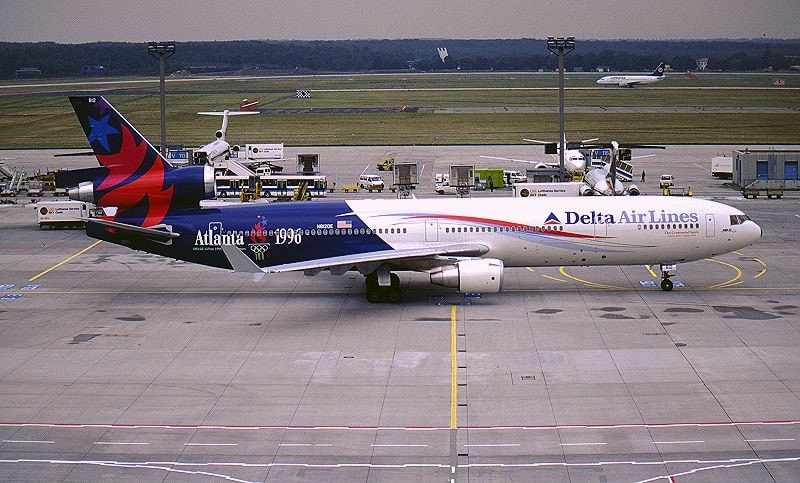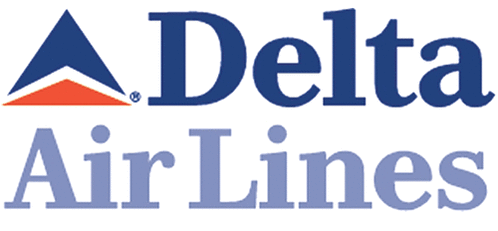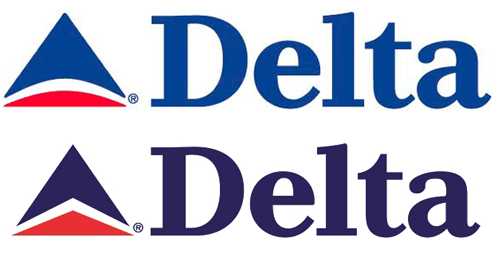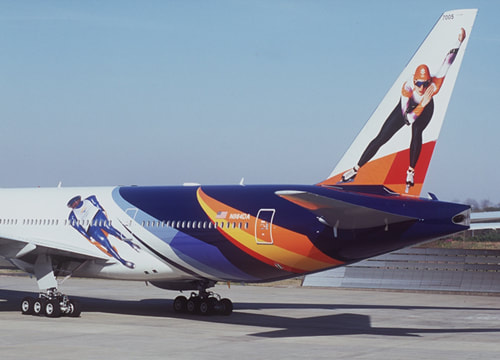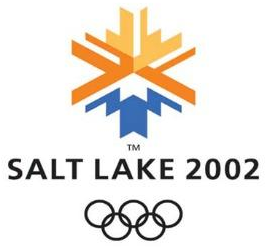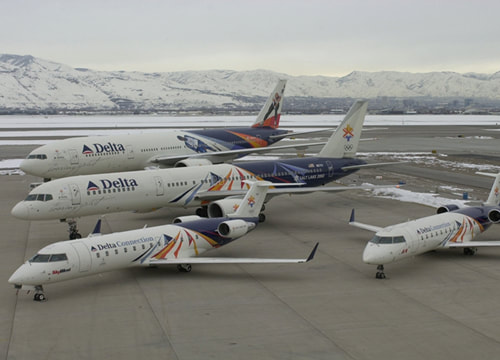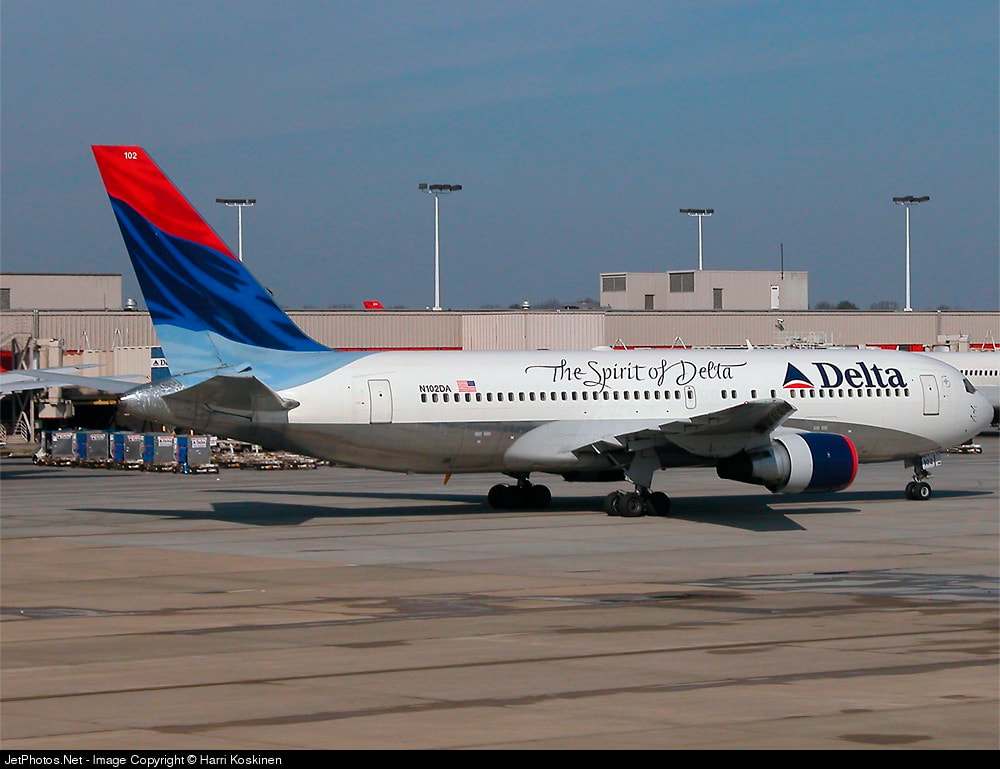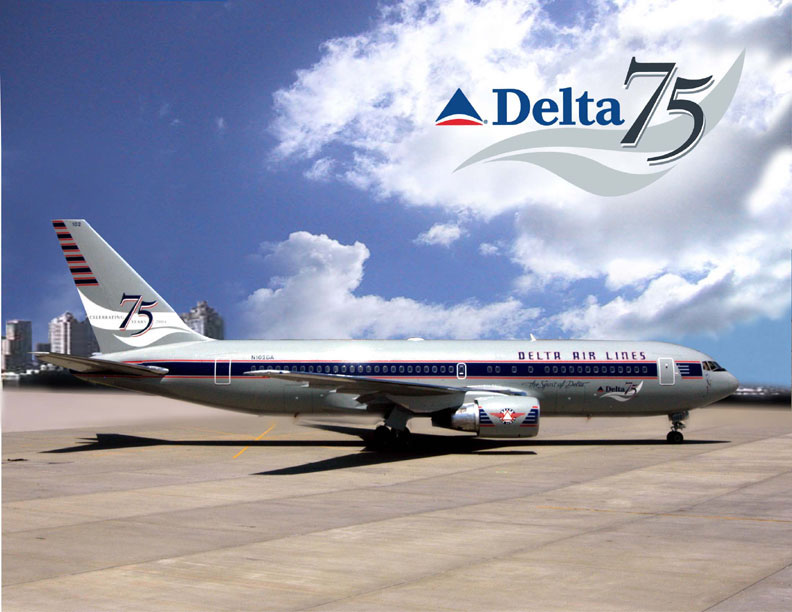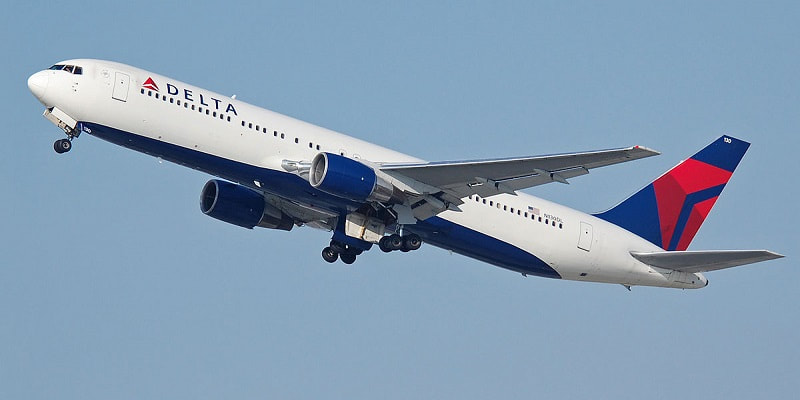Delta Air Lines Liveries
The intention of this page is to describe and show all the Delta Air Lines liveries from 1940 to the present day.
1940-1948: FLYING DELTA
|
Delta had had a few logos by the time the 1940 livery was introduced and in fact the logo to the left had been around since 1935. 1940 was the year Delta first introduced the DC-3, comparatively late for one of the US trunks and a clear sign of Delta's relatively lowly status. The scheme incorporated thick blue and thin red striping on the rudder, engines and as a feather behind the cockpit. The delta logo breaking out of its roundel was both forward and aft.
This scheme was worn by both the DC-3s and the civilianised C-54s (DC-4s). |
1948-1951: BAREMETAL FLYING D
|
Delta introduced its first DC-6 on December 1, 1948 and the aircraft (NC1901M) was named 'The Flying D'. This suitably christened the new livery and logo, which did away with the triangle and wings for a stylised Delta, that either sat on or inside a blue band outlined with thin red striping. Engines were also blue, as were the thick stripes on the wing behind the engines.
|
The tagline on the lower rear of the aircraft was 'The Airline of the South'.
1951-1959 (1968): WHITE CROWN FLYING D
In 1951 the 1948 livery gained the white crown that was becoming commonplace with airlines at the time. The 'Airline of the South' tagline was also dropped. There were several variations on the scheme depending on aircraft type, which affected the placement of the logo as follows:
Interestingly none of the piston propliners were ever painted in a livery beyond this one and well into the late 1960s the Convairs and Douglas DC-6/7s could be seen wearing this scheme.
- DC-3: As the 1948 scheme but with the cockpit enveloped in the dark blue mask
- C-46, DC-4, DC-6 and DC-7: Cheatline expanded to include the titles which were placed just aft of the cockpit.
- CV-440: Name was beneath the cockpit inside the cheatline
- Constellations: Delta titles carried below the cheatline.
Interestingly none of the piston propliners were ever painted in a livery beyond this one and well into the late 1960s the Convairs and Douglas DC-6/7s could be seen wearing this scheme.
1953-1955: DELTA C&S
1954-1959 (1967): GOLDEN CROWN DC-7B
|
When the first DC-7s joined the fleet they were used to introduce 'Golden Crown' service, which in terms of livery changes meant adding a metallic gold foil crown and DC-7 logo to the tail and 'Golden Crown DC-7' titles forward. Once again the DC-7s wore this scheme for their entire career (although some originally wore the Delta C&S colours.
|
1959-1962: DELTA ROYAL JET SERVICE (DC-8 DELIVERY)
|
Delta was not a fan of standard liveries in the early jet-era and the new DC-8s introduced a unique scheme. Interestingly the advertising for the new Royal jet Service actually used the first showing of the classic widget, but the DC-8s themselves didn't use it. Instead they had a new thunderbird logo on the nose and around the titles on the tail. In many ways the design was more of an evolution of the previous Flying D albeit with huge new DELTA AIR LINES titles.
|
1960-1968: ARISTOCRAT OF JETS (CV-880 DELIVERY)
|
The Convair 880s also gained a new unique livery when they entered service. The DC-8 thunderbird was gone and a more widget like tail logo adopted as well as the new 'Aristocrat of Jets' 880 crown logo.
|
1962-1968: CLASSIC WIDGET FULL TITLES
|
The arrival of the first DC-8-51 in 1962 introduced the next special jet livery but this one would develop into the standard Delta livery for over 30 years. The widget logo was expanded from the first Delta Royal Jet Service emblem and finally emblazoned on the aircraft. The DC-8s would also wear small Fanjet titles on the tail widget. As far as I can tell the first version of the livery was only actually worn by the DC-8-51s, first DC-8-61s and in modified form by the small fleet of cargo Hercules.
|
1965-1968: ROCKET WIDGET
|
Despite designing the livery that would effectively carry it through until the end of the century Delta still didn't want to standardise on a single scheme. The DC-9 fleet joined wearing a modified version with the Delta widget on its side, which has been nicknamed the rocket widget. The large and long DELTA AIR LINES titles barely fitted on the short DC-9-10s.
|
After the 1968 livery standardisation some of the DC-9s would get the shortened DELTA titles but keep the rocket widget for some time to come. This is shown by the model below:
1968-1982: CLASSIC WIDGET SHORT TITLES
|
By mid-1968 Delta had effectively four different liveries in circulation and a standardisation was overdue. As of September 1968 all aircraft would be repainted into the DC-8-51 widget scheme, albeit with the airline titles shortened to just DELTA. Interestingly the airline's official logo continued to not match what was on the aircraft.
|
This version of the livery was worn by the CV-880s, all DC-8s, DC-9s, DC-10s, 747-100s and the earliest 727s (first acquired as part of the takeover of Northeast Airlines). Some of the FH-227s acquired from Northeast also got into the full widget for a short period before they were sold. Interestingly the DC-8-61s never wore another scheme variant even after they had been converted into DC-8-71s and served into the late 80s.
1976: BICENTENNIAL LOGO
As part of the US Bicentennial celebrations Delta decided to modify its traditional widget logo turning it into a stars and stripes widget with the text "WE THE PEOPLE.... 1776-1976" underneath it. The phrase obviously refers to the preamble of the US Constitution, although Delta also said it referred to the spirit of their own personnel. The widget was worn during 1976 by 727-100/200s and L-1011s, although I'm uncertain how many of the fleet it adorned.
I've seen the logo applied to Tristars and 727s but I'm not sure if others wore it.
1973-1997: CLASSIC WIDGET TRISTARS
When the first Tristar arrived in December 1973 it sported the same widget livery as the rest of the fleet except that the forward dark blue chetaline flowed down onto the radome. Interestingly there were two variations of the natural metal belly configuration. The early Tristars had a gently flowing metal belly line with more white, whilst later Tristars had a metal belly line that followed the flow of the cheatline more closely. It seems that the selection of the metal belly configuration was more complex than this and both types overlapped for sometime in the fleet. Eventually the latter configuration with a larger metal belly was the survivor.
The image below shows the modified silver belly line that would become standard during the 1980s and 90s:
1982-1997: CLASSIC WIDGET DARK NOSE
|
With the delivery of the first 767-200s the Tristar style dark nose was adopted fleetwide (except for the DC-8s). It was applied to the existing 727-200s and DC-9s as well as new types (737-200s, 757s, 767s, MD-11s, MD-80s, MD-90s and A310s). It was also worn by ex-Western 727s, 737-200/300s and DC-10s inherited as part of the takeover.
|
There was even variation in this scheme however in relation to the silver belly. Initially the silver belly followed the line of the cheatline leaving a white margin between the silver and dark blue (see the 737-200 and 757-200 models above). The later version of the scheme introduced towards the end of the 1980s (I think) changed this and the silver now was more extensive and meets the dark blue under the nose. N608DL, a 757 that has been preserved by Delta, actually wears the later variation as you can see below:
1982-1995 / 1996-2002: N102DA SPIRIT OF DELTA WIDGET
Delta's first 767 (now preserved) was famously purchased by company staff - see:
|
N102DA wore a slightly modified version of the standard Widget colours with the forward widget outlined in gold and 'The Spirit of Delta' titles on the upper fuselage and nose. She wore this scheme the first time until being repainted into Olympic colours in late 1995. She was repainted into this scheme again by 1997 and wore it until June 2002.
|
|
1995-1997: CENTENNIAL SPIRIT / ATLANTA OLYMPICS
To celebrate the 1996 Atlanta Olympic Games Delta painted two aircraft into special colours. One was N102DA 'The Spirit of Delta' 767-200 and the other was the MD-11 N812DE. The 767 was still 'The Spirit of Delta' but the MD-11 was named 'Centennial Spirit' celebrating 100 years of the Olympics. It was the MD-11 that carried the Olympic flame to Atlanta. Even when repainted into the Landor standard colours N812DE kept her name.
Many other aircraft in the fleet wore 'The Official Airline 1996 Olympic Games' stickers on the lower forward fuselage.
Many other aircraft in the fleet wore 'The Official Airline 1996 Olympic Games' stickers on the lower forward fuselage.
1997-2000: RON ALLEN / LANDOR
|
The updated titles to the left were used from March 1995, however the Landor designed colours weren't implemented until April 10, 1997 by the outgoing CEO Ron Allen. The livery was decidedly unadventurous but reasonably smart. It was never worn by any of the Tristars but was applied to the 727s, 737s, 757s, 767s, MD-11s, MD-80s and MD-90s. It was also the first scheme worn by the new 737-800s, 777s and 767-400s. This livery only survived for a short period and not all the fleet ever wore it. Many aircraft went straight from their Widget scheme directly into the 2000 colours.
|
1996-2003: DELTA EXPRESS
Delta's first attempt at 'an airline within an airline' used just 737-200s. They wore either the Widget, Ron Allen or Colors in Motion schemes depending on era with 'Express' titles added.
2000-2007: COLORS IN MOTION / WAVY GRAVY / DELTAFLOT
|
The 2000 colours heralded a bolder but simpler change from the unloved Ron Allen scheme. The tail colours gained it several nicknames alongside the official 'Colors in Motion' title.
During its application Delta wore two different style widgets. Firstly the 'Soft Widget' used from March 2000 to July 2004 and secondly the 'Heritage Widget' worn from July 2004 to April 30, 2007. |
2002: SOARING SPIRIT WINTER OLYMPICS
2002-2004: N102DA SPIRIT OF DELTA COLORS IN MOTION
N102DA 'The Spirit of Delta' wore the 'Colors in Motion' scheme but with additional titles. She wore this scheme from June 2002 until repainted into the 75th anniversary colours in April 2004.
2004-2006: N102DA 75TH ANNIVERSARY
The Spirit of Delta's last in-service scheme was in honour of the airline's 75th anniversary. She wore this until she was retired on February 12, 2006. She was then repainted into her original colours for a farewell tour and preservation at the Delta Flight Museum.
2003-2006: SONG
Delta's second 'airline within an airline' used 48 757s in a single class layout. It survived from April 2003 until May 2006.
2007-PRESENT: ONWARD & UPWARD / 3D RED WIDGET
|
Delta's current scheme was inaugurated on April 30, 2007 when the airline emerged from bankruptcy protection. It was designed by Lippincott Mercer. The new livery was substantially simpler than the previous as it only consists of four colours. It also cleverly honours the history of Northwest Airlines.
|
In May 2015, Delta added its name in white to the blue belly of its planes.
2006-PRESENT: OTHER SPECIAL SCHEMES
Since 2006 Delta has had several other special schemes which are detailed on the following page:

